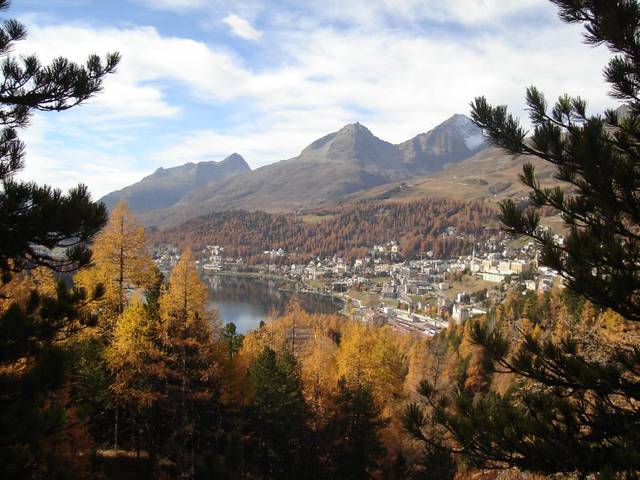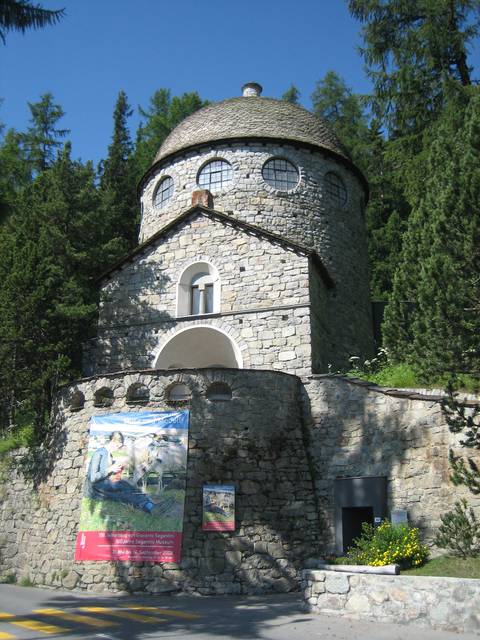St. Moritz is located in the Upper Engadin in the canton of Graubünden in Switzerland. It is one of the best-known vacation spots in Europe. It is chic and famous for its ambiance, and is situated next to Engadine's lakescape at 1,856 metres above sea level. The bubbly "champagne atmosphere" is as legendary as the St. Moritz sun, which shines on an average 322 days a year!

- Berry Museum, Via Arona 32, 7500 St. Moritz, +41 81 833 30 18. 10:00–13:00/16:00–19:00. The Berry Museum, which is housed in the 100-year old Villa Arona in the heart of St. Moritz, is dedicated to the spa physician and painter, Peter Robert Berry (1864–1942). The majority of his oil paintings, pastels and drawings produced over a period of forty years are still in family ownership. Fr. 15/10.
- Chesa Futura. Designed by the English star architect, Lord Norman Foster, Chesa Futura houses ten private apartments with a beautiful view of the St. Moritz lake. Its façade is made of local larch clapboards.
- Chesa Veglia. Dating from 1658, it is one of the oldest farmhouses in St. Moritz. Now it houses three restaurants and two bars. The grill Chadafö provides the perfect setting for elegant dining with classic French cuisine. The two bars – the Polo Bar and Carigiet – are the perfect places to enjoy pre- and after-dinner drinks and are ideally suited for a get-together.
- Cresta Run. Cresta run is the only natural skeleton downhill course. The first race was held in 1884/85. Spectacular races or training runs take place every day from the end of December to the beginning of March.
- Heidi hut. The well-known story of the Swiss Heidi was filmed in the Engadin. The Heidi hut is located above St. Moritz and is among the most famous sightseeing attractions.
- Leaning tower. It is the symbol of St. Moritz. It dates back to the 12th century. It is opposite the Kulm Hotel.
- St. Moritz 5-star hotels. St. Moritz is very well-known also because of its “Big 5”. The “Big 5” are the 5-star hotels including Badrutt’s Palace, Kempinski Grand Hotel des Bains, Carlton, Kulm and Suvretta House.

- Segantini Museum. Built in 1908 by the architect Nicolaus Hartmann, the museum displays works by the painter Giovanni Segantini.
- The St. Moritz “Trambänkli”. The St. Moritz tram was one of the first electric trams in Switzerland. The “Trambänkli” is a waiting station for passengers. In the 19th century, it was a tram station. Now, it is a bus station.
Berry Museum, Via Arona 32, 7500 St. Moritz, +41 81 833 30 18. 10:00–13:00/16:00–19:00. The Berry Museum, which is housed in the 100-year old Villa Arona in the heart of St. Moritz, is dedicated to the spa physician and painter, Peter Robert Berry (1864–1942). The majority of his oil paintings, pastels and drawings produced over a period of forty years are still in family ownership. Fr. 15/10.
Chesa Futura. Designed by the English star architect, Lord Norman Foster, Chesa Futura houses ten private apartments with a beautiful view of the St. Moritz lake. Its façade is made of local larch clapboards.
Chesa Veglia. Dating from 1658, it is one of the oldest farmhouses in St. Moritz. Now it houses three restaurants and two bars. The grill Chadafö provides the perfect setting for elegant dining with classic French cuisine. The two bars – the Polo Bar and Carigiet – are the perfect places to enjoy pre- and after-dinner drinks and are ideally suited for a get-together.
Cresta Run. Cresta run is the only natural skeleton downhill course. The first race was held in 1884/85. Spectacular races or training runs take place every day from the end of December to the beginning of March.
Heidi hut. The well-known story of the Swiss Heidi was filmed in the Engadin. The Heidi hut is located above St. Moritz and is among the most famous sightseeing attractions.
Leaning tower. It is the symbol of St. Moritz. It dates back to the 12th century. It is opposite the Kulm Hotel.
St. Moritz 5-star hotels. St. Moritz is very well-known also because of its “Big 5”. The “Big 5” are the 5-star hotels including Badrutt’s Palace, Kempinski Grand Hotel des Bains, Carlton, Kulm and Suvretta House.
Segantini Museum. Built in 1908 by the architect Nicolaus Hartmann, the museum displays works by the painter Giovanni Segantini.
The St. Moritz “Trambänkli”. The St. Moritz tram was one of the first electric trams in Switzerland. The “Trambänkli” is a waiting station for passengers. In the 19th century, it was a tram station. Now, it is a bus station.
There are a lot of events in St. Moritz such as operas in all seasons, the British Classic Car Meeting, the surf marathon, the city race, the gourmet festival, etc. For an overview of the upcoming events, take a look at the event calendar of the Engadin .
- Mountain biking. A true bikers’ paradise exists between the highest peaks of the eastern Alps. There are 400 km of pure riding pleasure with routes for all levels of difficulty.
- Skiing and snowboarding. There are four ski regions in and around St. Moritz. They offer 350 kilometres of prepared slopes and 34 cosy restaurants. Moreover, there are a number of snowsports schools in St. Moritz.
* Corviglia.
* Corvatsch.
* Diavolezza.
* Zuoz.
- Ice-skating in summer. There is an artificial ice-rink that is open from mid-July to mid-April. The following activities and services are available: ice skating for everyone, curling, ice rental, and special events on request.
- Walking and hiking. In St. Moritz walking/hiking is always a spectacular experience. There are over 580 km of hiking trails. Visitors in a wheelchair do not fall short since there are 9 wheelchair-accessible hikes. The best about hiking in St. Moritz is that the cable cars are included if staying at a hotel for two nights or longer. Good starting points is e.g. Corviglia or one of the following:
* Muottas Muragl.
* Schellen-Ursli weg. 1.5 km long trail named after a children’s character, suitable for pushchairs too.
- Windsurfing at Silvanplana. The lake is well known for its predictable winds and is therefore a popular venue for water-sailsports including particularly windsurfing, kitesurfing and dinghy-sailing. There is a major watersports centre on the SW shore.
Mountain biking. A true bikers’ paradise exists between the highest peaks of the eastern Alps. There are 400 km of pure riding pleasure with routes for all levels of difficulty.
Skiing and snowboarding. There are four ski regions in and around St. Moritz. They offer 350 kilometres of prepared slopes and 34 cosy restaurants. Moreover, there are a number of snowsports schools in St. Moritz.
* Corviglia.
* Corvatsch.
* Diavolezza.
* Zuoz.
Ice-skating in summer. There is an artificial ice-rink that is open from mid-July to mid-April. The following activities and services are available: ice skating for everyone, curling, ice rental, and special events on request.
Walking and hiking. In St. Moritz walking/hiking is always a spectacular experience. There are over 580 km of hiking trails. Visitors in a wheelchair do not fall short since there are 9 wheelchair-accessible hikes. The best about hiking in St. Moritz is that the cable cars are included if staying at a hotel for two nights or longer. Good starting points is e.g. Corviglia or one of the following:
* Muottas Muragl.
* Schellen-Ursli weg. 1.5 km long trail named after a children’s character, suitable for pushchairs too.
Windsurfing at Silvanplana. The lake is well known for its predictable winds and is therefore a popular venue for water-sailsports including particularly windsurfing, kitesurfing and dinghy-sailing. There is a major watersports centre on the SW shore.
- Via Serlas. It is one of the most exclusive shopping streets in the world. Glamour, luxury, and large retail chains door to door.
Via Serlas. It is one of the most exclusive shopping streets in the world. Glamour, luxury, and large retail chains door to door.
- Restaurant Engiadina, Via Dimlej 1 (50 metres behind the railway station., +41 81 833 30 00.
Restaurant Engiadina, Via Dimlej 1 (50 metres behind the railway station., +41 81 833 30 00.
Livigno is just behind the borders, accessible via Bernina Pass.
